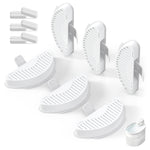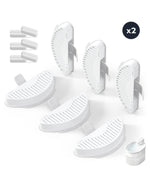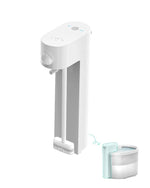For pet owners, the joy of having a furry companion often comes with the challenge of managing pet dander. This microscopic flake of skin can trigger allergies, asthma, and other respiratory issues, making it essential to find the right air purifier. But with so many options available, how do you determine which air purifier is best for pet dander? This guide will walk you through the essential features to consider, helping you make an informed decision for a healthier home environment.
Understanding Pet Dander and Its Impact
Pet dander consists of tiny, even microscopic, flecks of skin shed by cats, dogs, rodents, birds, and other animals with fur or feathers. These particles can linger in the air and settle on surfaces, making them difficult to eliminate. For individuals with allergies or asthma, pet dander can be a significant irritant, leading to symptoms like sneezing, coughing, and itchy eyes. An effective air purifier can help reduce these particles, improving indoor air quality and overall comfort.
Key Features to Look for in an Air Purifier
When selecting an air purifier for pet dander, several features are crucial to ensure optimal performance. Here are the most important factors to consider:
HEPA Filtration
High-Efficiency Particulate Air (HEPA) filters are the gold standard for capturing airborne particles, including pet dander. These filters can trap particles as small as 0.3 microns with an efficiency of 99.97%. Look for an air purifier with a true HEPA filter to ensure it can effectively remove pet dander from your home.
Activated Carbon Filter
While HEPA filters are excellent for capturing particles, they may not address odors associated with pets. An activated carbon filter can help neutralize pet odors, making your home smell fresher. This type of filter is particularly useful if you have multiple pets or if your pets spend a lot of time indoors.
Air Change Rate
The air change rate refers to how many times an air purifier can filter the entire volume of air in a room per hour. For pet owners, a higher air change rate is beneficial as it ensures that pet dander is continuously removed from the air. Look for an air purifier with an air change rate of at least four times per hour for optimal performance.
Room Size Coverage
Consider the size of the room where you plan to use the air purifier. Different models are designed to cover various room sizes, so it's essential to choose one that matches your needs. An air purifier that's too small for your space won't be effective, while one that's too large may be unnecessarily expensive.
Noise Level
If you plan to run the air purifier continuously, especially in bedrooms or living areas, noise level is an important consideration. Look for a model that operates quietly, particularly on lower settings, to ensure it doesn't disrupt your daily activities or sleep.
Maintenance and Filter Replacement
Regular maintenance is crucial for keeping an air purifier effective. Check the manufacturer's recommendations for filter replacement and cleaning. Some models have washable filters, which can be more cost-effective in the long run, while others require periodic replacement. Consider the ongoing costs and effort involved in maintaining the air purifier.
Additional Considerations for Pet Owners
Beyond the core features, there are a few additional factors that pet owners should keep in mind when choosing an air purifier:
Multiple Pets
If you have more than one pet, you may need a more robust air purifier to handle the increased amount of dander and hair. Look for models with higher CADR (Clean Air Delivery Rate) ratings, which indicate the volume of clean air produced per minute.
Allergies and Asthma
For households with individuals who suffer from allergies or asthma, it's essential to choose an air purifier that can effectively remove allergens from the air. In addition to HEPA filtration, consider models with additional features like ionizers or UV-C light, which can help neutralize bacteria and viruses.
Portability
If you plan to move the air purifier between rooms, consider its size and weight. Some models come with casters or handles, making them easier to transport. Portability can be particularly useful if you have pets that spend time in different areas of your home.
Energy Efficiency
Running an air purifier continuously can increase your energy consumption. Look for models with energy-efficient ratings to minimize the impact on your electricity bill. Some air purifiers also have eco-friendly modes that adjust the fan speed based on air quality, further reducing energy usage.
Tips for Maximizing Air Purifier Effectiveness
To get the most out of your air purifier, follow these tips:
Placement Matters
Position the air purifier in a central location within the room to ensure optimal air circulation. Avoid placing it near walls or furniture that could obstruct airflow. If you have multiple pets, consider placing the air purifier in the area where they spend the most time.
Regular Cleaning
In addition to maintaining the air purifier, regularly clean your home to reduce the accumulation of pet dander. Vacuum carpets, upholstery, and pet bedding frequently, and consider using a vacuum with a HEPA filter to capture more particles.
Groom Your Pets
Regular grooming can help reduce the amount of dander your pets shed. Brush your pets frequently and bathe them as recommended by your veterinarian. This not only helps control dander but also keeps your pets healthy and comfortable.
Monitor Air Quality
Some air purifiers come with built-in air quality sensors that provide real-time feedback on the air in your home. Use this feature to monitor the effectiveness of your air purifier and make adjustments as needed.
Common Myths About Air Purifiers and Pet Dander
There are several misconceptions about air purifiers and their ability to handle pet dander. Here are a few myths debunked:
Myth 1: All Air Purifiers Are the Same
Not all air purifiers are created equal. Models with HEPA filters are far more effective at capturing pet dander than those without. Additionally, features like activated carbon filters and air change rates can significantly impact performance.
Myth 2: Air Purifiers Eliminate the Need for Cleaning
While air purifiers can help reduce airborne pet dander, they are not a substitute for regular cleaning. Vacuuming, dusting, and grooming your pets are still essential for maintaining a healthy home environment.
Myth 3: Air Purifiers Are Noisy and Inconvenient
Modern air purifiers are designed to operate quietly, especially on lower settings. Many models also come with features like timers and auto modes, making them convenient to use.
Final Thoughts
Choosing the right air purifier for pet dander can make a significant difference in your home's air quality and your overall comfort. By focusing on key features like HEPA filtration, activated carbon filters, and air change rates, you can find a model that effectively tackles pet dander and other allergens. Remember to consider additional factors like room size, noise level, and maintenance requirements to ensure the air purifier meets your specific needs. With the right air purifier in place, you and your pets can enjoy a cleaner, healthier living environment.












